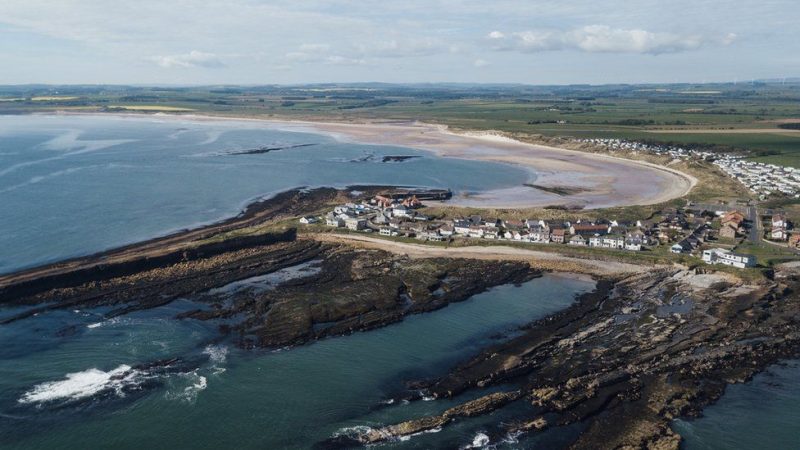Nestled along Northumberland’s rugged coastline, Beadnell is a haven for nature lovers and wildlife enthusiasts alike. This charming village, with its dramatic cliffs and sandy beaches, offers a unique glimpse into the diverse ecosystems of the Northumberland coast. From seabirds to seals, Beadnell provides unparalleled opportunities for wildlife encounters. Whether you’re an avid birder, a seal enthusiast, or simply looking to connect with nature, Beadnell’s wildlife promises memorable experiences. In this article, we’ll explore ten amazing wildlife encounters you can have in Beadnell and the surrounding areas, showcasing the natural beauty and rich biodiversity of this coastal gem.
Beadnell Bay’s Seals: A Coastal Delight
Beadnell Bay is renowned for its seal population. During low tide, the sandy banks and rocky outcrops become prime lounging spots for both common and grey seals. These curious creatures can often be seen basking in the sun or playing in the water. To observe seals up close, head to Beadnell Bay early in the morning or late in the afternoon when they are most active. Binoculars and a telephoto lens will enhance your viewing experience, allowing you to watch their playful antics without disturbing their natural behaviour.
Puffin Watching on Inner Farne: A Short Trip from Beadnell
A short boat ride from Beadnell takes you to the Farne Islands, home to a spectacular puffin colony. These colourful seabirds are a highlight of the summer months, with their vibrant beaks and comical personalities. The puffins arrive in April and stay until August, making it the perfect time to witness their nesting and breeding behaviours. Boat tours around the islands provide excellent vantage points for observing puffins as they dive for fish and interact with their mates.
Beadnell Marsh: A Birdwatcher’s Paradise
Beadnell Marsh, a protected nature reserve, is a hotspot for birdwatching. This wetland area attracts a variety of bird species throughout the year, including waders, ducks, and reed warblers. During migration seasons, rare and unusual species can be spotted. The marsh is also home to a variety of insects and amphibians, making it a vibrant ecosystem. A walk around the marsh trails offers opportunities to see and hear a diverse range of wildlife, from the elusive water rail to the chirping of dragonflies.
Discovering Coastal Wildflowers in Beadnell
The coastal paths around Beadnell are adorned with a stunning array of wildflowers. During the spring and summer months, the cliffs and dunes bloom with vibrant colours. Look out for species such as sea pinks, yellow horned poppy, and wild thyme. These flowers not only add beauty to the landscape but also provide essential nectar for pollinators like bees and butterflies. Walking along the coastal paths, you’ll find yourself immersed in a tapestry of colour and fragrance.
Observing Dolphins and Whales Along the Northumberland Coast
The Northumberland coast offers occasional sightings of dolphins and even whales. Although less common than seals and puffins, these magnificent marine mammals can be spotted from the shore or on boat tours. Bottlenose dolphins and minke whales are among the species that grace these waters, particularly during the summer months. Joining a wildlife cruise or guided boat tour increases your chances of encountering these elusive creatures. Keep a keen eye on the horizon and have your camera ready for a chance to capture these rare and awe-inspiring moments.
The Secretive Otters of the Coastal Streams
Otters are elusive and nocturnal, making them a challenging yet rewarding sight. Coastal streams and estuaries in Northumberland provide ideal habitats for these playful mammals. Although difficult to spot during daylight hours, early morning or dusk are the best times to see otters. Look for signs such as their tracks along the water’s edge or distinctive spraints (faeces) on rocks. Engaging with local wildlife guides or naturalists can provide valuable insights and tips on where and when to search for these secretive animals.
Exploring the Rock Pools and Marine Life
The rock pools along the coastline are teeming with fascinating marine life. During low tide, these small, sheltered ecosystems reveal a variety of creatures such as crabs, starfish, and sea anemones. Exploring rock pools is a captivating activity for all ages. Use water shoes and a small net to enhance your exploration, but remember to tread carefully and avoid disturbing the delicate balance of these habitats. By observing and learning about the diverse species found in the rock pools, you can gain a deeper appreciation for the underwater world.
Bird Watching at Newton Point
Newton Point, a rugged promontory near the coast, is an excellent location for birdwatching. The varied habitats here, including cliffs, heathland, and grassland, attract a wide range of bird species. Peregrine falcons, kestrels, and buzzards are frequently seen soaring above the cliffs. During migration seasons in spring and autumn, the area becomes a vital stopover for migrating birds. Bring a field guide and binoculars to help identify the diverse species and enjoy the stunning views of the coastal landscape.
The Beauty of Marine Life in the Bay
Beneath the waves lies a rich marine ecosystem that is best explored through snorkelling or diving. The bay’s clear waters and relatively shallow depths offer a glimpse into a vibrant underwater world. Divers and snorkelers can discover various fish species, sea urchins, and kelp forests. Local dive shops offer guided trips and equipment rental, making it accessible for both beginners and experienced divers. Exploring the bay’s marine life reveals the hidden beauty of the ocean and its diverse inhabitants.
The Charm of Coastal Erosion and Geology
The coastal erosion around the area has created a dramatic and rugged landscape that influences local wildlife. The eroded cliffs and rocky outcrops are home to seabirds and plants adapted to the harsh conditions. Exploring these geological features offers insight into the natural processes that shape the coast. Look for fossils embedded in the rocks or enjoy the breathtaking views from the cliff tops. Understanding the geology and erosion patterns enhances your appreciation of the natural beauty and ecological significance of the coastline.
Conclusion
Beadnell’s wildlife encounters offer a diverse array of experiences that highlight the natural beauty of Northumberland’s coast. From the playful seals of Beadnell Bay to the colourful puffins of the Farne Islands, each encounter provides a unique glimpse into the region’s rich biodiversity. Whether you’re exploring rock pools, watching dolphins, or enjoying the floral displays, Beadnell promises unforgettable moments for nature enthusiasts. By respecting and preserving these natural habitats, we can ensure that future generations also have the chance to experience the wonders of Beadnell’s wildlife.
FAQs
1. What is the best time to see seals in Beadnell Bay?
Seals are most commonly seen during low tide in the early morning or late afternoon. This is when they are most active and can be found basking on the sandy banks and rocky outcrops.
2. When is the ideal time to visit the Farne Islands for puffin watching?
The best time to visit the Farne Islands for puffin watching is from April to August. During these months, puffins are nesting and breeding, making it the perfect time to observe their behaviours.
3. How can I increase my chances of spotting dolphins and whales?
To increase your chances of spotting dolphins and whales, consider joining a wildlife cruise or boat tour. These excursions provide better visibility and access to areas where these marine mammals are known to appear.
4. What should I look for when trying to spot otters?
Otters are best spotted early in the morning or at dusk. Look for signs such as their tracks along the water’s edge or spraints (faeces) on rocks. Engaging with local wildlife guides can also help you find them more easily.
5. What equipment should I bring for rock pooling?
For rock pooling, bring water shoes or sturdy footwear, a small net, and a container for observing marine life. Handle all creatures gently and ensure you return them to their habitat carefully to avoid disrupting their environment.
Also read: Wilksworth Caravan Park: 10 Reasons Why It’s the Perfect Getaway









